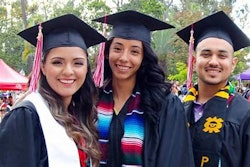Presidential Candidates Make Higher Education Rounds
By Jamilah Evelyn
Higher education finally took center stage in the presidential election last month when Republican nominee George W. Bush made a campaign stop at historically Black Dillard University and Democratic nominee Al Gore visited the University of Maryland.
Setting his sights on pulling Louisiana back into the Republican fold for the first time in a presidential election since 1988, Bush discussed his education platform and also sought to reach out to minority groups during his visit to Dillard and New Orleans.
His most notable announcement was a proposal to increase federal aid to minority-serving institutions to a sum of more than $600 million over five years. Bush said he would increase federal aid to 104 historically Black colleges to $320 million per year over five years, up from the current $180 million per year. Under the same proposal, aid to the 195 Hispanic-serving institutions would be increased to $80 million per year from $42 million, also over five years.
Bush also called for a $1 million increase in the federal Pell grant program that would allow an extra $1,000 for students who achieve in advanced math and science courses.
“It’s hard not to think that’s a good idea,” says Dr. Michael Lomax, Dillard’s president, who says he has invited both candidates to come to the school. “Obviously increases in Title III and enhancements in Pell are both timely and important for our institutions. I hope the forum gave greater visibility to these issues.”
Also in attendance was Dr. Norman Francis, the 32-year president of nearby Xavier University. Francis pitched his idea that students in their first two years of college would be better assisted by increased grant opportunities than by taking out more loans, since the lighter financial burden would improve their chances of finishing
college.
Only a handful of students were allowed to attend the forum, which featured about 100 school officials, politicians and other dignitaries.
Freshman Silika Simmons, 18, of Dallas, was among those who had hoped to see Bush in person but didn’t get the chance. Simmons says she was glad Bush came to speak about education and minority issues, but wondered if the message would be sincere.
“Now since it’s election time, it’s kind of wishy-washy,” Simmons says. “It might be genuine. But he might be doing it for votes.”
She also doubted many Dillard students would vote for Bush, who was accompanied during his visit by U.S. Rep. J.C. Watts, R-Okla.
“There’s probably only one or two Republicans in the whole freshman class,” Simmons says.
Bush’s visit and increased attention to Black college issues comes on the heels of Watts’ Republican HBCU summit, which raised eyebrows earlier this summer and drew backlash from
Democratic legislators who balked at their exclusion (see Black Issues, Aug. 17). Addressing questions concerning Republican efforts to win over the Black college constituency, Francis says that he’s willing to work both sides of the aisle to raise awareness of his
concerns.
“The key here is that we got an opportunity to voice our issues. When a major political candidate comes, so do the reporters. And so now more people are aware of our issues,” he says. “Not to mention that Gov. Bush is now more aware of our issues and understands the role that we play in this country. I certainly do hope that there is a degree of commitment and sincerity on [Bush’s] part.
“I didn’t promise him I’d vote for him,” he adds. “I came to talk about an issue.”
Francis also notes that Black colleges made some surprising gains under presidents Ronald Reagan and Richard Nixon, both Republicans. Reagan, for example, signed Title III, Sect. B, Francis says, a part of the higher education authorization that establishes funds for historically Black graduate institutions.
Trey Ourso, executive director of the Louisiana Democratic Party, says he does not expect Bush’s visit to Dillard to significantly swing Louisiana’s minority vote.
“The Democratic party has had a long history of supporting public education and inclusion of people of all races and backgrounds,” Ourso says. “When people go to vote, they’ll be able to recognize who has a long history of doing this and who’s making a campaign stop two months before the election.”
Dillard traditionally invites presidential candidates to its campus for policy discussions and four of the last five presidents, including the elder George Bush, have visited either while in office or campaigning, Lomax says.
“We do this on a regular basis and in a bipartisan way,” Lomax says. “We treat this as a serious opportunity to raise issues.”
Meanwhile, Vice President Gore spoke at the University of Maryland at College Park, pushing his proposals to help lower- and middle-income families pay for college through tax credits. Calling the Democratic plan the “largest investment in education since the G.I. Bill,” Gore says he supports allowing families the choice between a $10,000 per year tax deduction or a $2,800 tax credit.
Gore also has called for a federal program that would tie together state tuition-saving plans and new 401(j) accounts that would allow employers to help workers save for college.
© Copyright 2005 by DiverseEducation.com


















